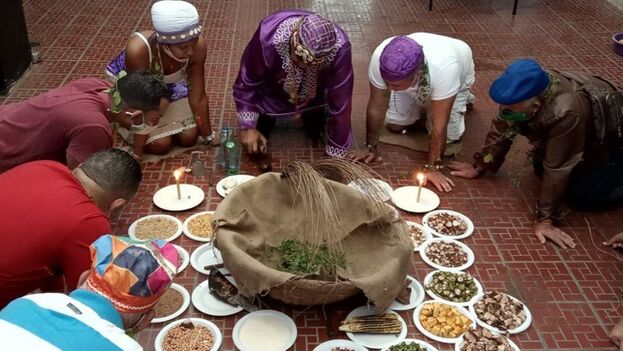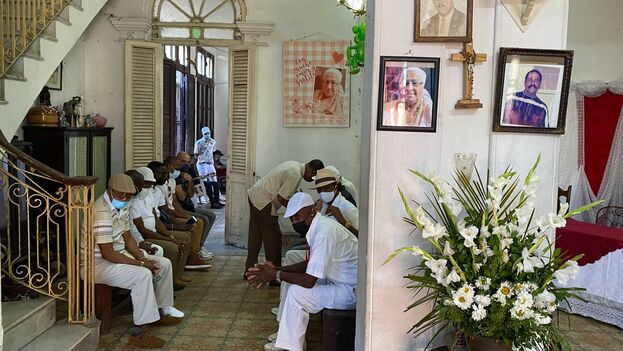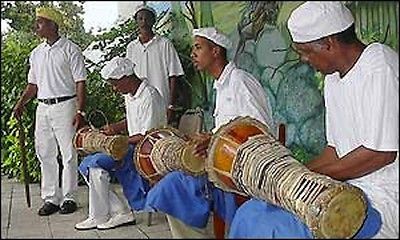LA SANTERÍA SE EXTIENDE EN CUBA ANTE LAS DIFICULTADES DE LA VIDA. PHOTOS.
Los creyentes “modernos” exigen la solución de sus problemas amorosos, las “limpias” para mejorar la suerte personal y protección mágica para lidiar con la justicia. Como ocurrió en el Período Especial, la religión vuelve a adquirir en la Isla una especie de condición “anestésica” ante las dificultades de la vida. La gente reza, busca respuestas, confía en el “más allá” y consulta todo tipo de mecanismos adivinatorios para saber cuánto tiempo más hay que “resistir”.

Como ocurrió en el Período Especial, la religión vuelve a adquirir en la Isla una especie de condición “anestésica”. (Asociación Cultural Yoruba)
COMO UN JOVEN ADIVINO o un brujo de ‘Las mil y una noches’, en la memoria de Omar se mezclan ritos, conjuros, relatos y palabras en lenguas antiguas. Hablador, de piel tostada y ojos despiertos, vive entre libros y objetos sagrados de la Regla de Ocha.
Omar ha tratado de comprender la santería desde la práctica, el respeto y la racionalidad. Desprovisto de fanatismos y abierto al diálogo, hay pocas personas en Santa Clara –ciudad que es un laberinto de creencias– con las que se pueda hablar con tanta seriedad sobre el universo religioso afrocubano.
En esa conversación con Omar, se trata de averiguar por qué a las celebridades y políticos cubanos les interesa tanto la santería y cuál es el “estado de salud” de esta religión en la Isla. No deja de intrigar el hecho de que existan facciones afines al Gobierno y babalawos “independientes” que predicen su inminente caída.
La política, la religión, el miedo, el honor entre iniciados, la superstición, la usurpación de elementos rituales por la Seguridad del Estado, para atemorizar a los disidentes… la lista de temas agotaría la serenidad de un interlocutor razonable. Pero Omar es paciente, como un hechicero anciano, y comienza a buscar las causas del problema.
El Período Especial y el nuevo milenio trajeron más cambios para la Regla de Ocha: se encarecieron las iniciaciones y se comenzó un proceso de mercantilización.
“La religión afrocubana está en todos lados”, afirma. “Penetra la jerga, la gestualidad, los imaginarios, moldea la guapería nacional, y hasta le da forma a lo peor de los cubanos, en un proceso donde muchos elementos salen para ser sustituidos por otros de inquietante procedencia”.
MIGUEL FEBLES, “ALIVIO” LOS RIGORES DE LA INICIACION…
“El primer signo de este ‘desmadre'”, explica Omar, “se puede hallar en lo que alguien llamó el baby boom de los babalawos en los años ochenta y noventa”. Este auge se produjo gracias a Miguel Febles (1910-1986), un santero que “alivió” los rigurosos controles para iniciarse en la religión.
El centro de la consagración de un babalawo es el “fundamento”, un orisha o fetiche sobre el cual se realiza la ceremonia. Antes de Febles, el número de fundamentos era muy reducido, y para iniciar a un nuevo babalawo tenía que prestarse o alquilarse, a menudo desde una ciudad a otra.
“Febles flexibilizó el rigor a la hora de entregar el fetiche”, afirma Omar, “en favor de las capacidades económicas de quien pretendiera recibirlo. Eso garantizó un crecimiento aritmético del número de consagraciones”.
El babalawo había sido moldeado tradicionalmente según criterios muy parecidos a los de la masonería: debía ser heterosexual, “sabio”, buen hijo, padre y esposo, con disponibilidad para avanzar en el estudio de la religión. Pero, después de la reforma de Febles, ese ideal se desdibujó y “se comenzaron a consagrar personas de muy variada índole, entre los que se encontraban muchos pepillos, maleantes, proxenetas y profesionales de distintas ramas”.
El Período Especial y el nuevo milenio trajeron más cambios para la Regla de Ocha: se encarecieron las iniciaciones, se comenzó un proceso de mercantilización –el beneficio monetario antes que el espiritual– y los santeros se sumergieron en una suerte de “modelo de éxito”. Por no hablar de la “invención” de orishas para atraer a los turistas que venían buscando una religión “exótica” y criolla.
“En esta nueva dinámica”, lamenta Omar, “la gente pide tres cosas fundamentales: solución de problemas amorosos con brujerías o amarres; las limpias para mejorar la suerte personal; y protección mágica para lidiar con la justicia”.

La santería, practicada de modo más o menos ortodoxo por muchos cubanos, enfrenta también al éxodo masivo que experimenta la Isla. (14ymedio)
Añade que “las condiciones azarosas de vida que enfrenta el cubano condicionan la búsqueda de una seguridad en el plano esotérico, precisamente porque se quiere controlar el caos que se vive a diario mediante la intervención de la magia”.
Omar se refiere, no sin incomodidad, a los artistas cubanos que han hecho de la santería una especie de “sello”. “Luna Manzanares se paseó de iyawo durante los funerales faraónicos de Fidel Castro”, dice, “a sabiendas de que un iyawo tiene prohibido participar en actividades fúnebres o entrar en cementerios”.
“Kimiko y Yordi hicieron su video más famoso, El campeón, vestidos de iyawos, aún cuando sabían que en su estado es tabú tomarse fotos o aparecer en un video. Pero estos artistas no hacían más que reproducir lo que en otros momentos habían hecho Chacal y Yakarta, y muchos otros más. Hoy los timberos celebran con temas musicales su acceso al culto más misógino y exclusivo de Ifá, de acuerdo a la tendencia que iniciara Adalberto Álvarez cuando se hizo babalawo”.
La gente reza, busca respuestas, confía en el “más allá” y consulta todo tipo de mecanismos adivinatorios para saber cuánto tiempo más hay que “resistir”
Omar no habla del “acercamiento” de los dirigentes del Partido Comunista a la santería, considerada como “religión extraoficial” del Comité Central, ni de los “santos” atribuidos a Díaz-Canel y demás personajes del Gobierno. “No tenía idea de que se usaran elementos de la Ocha, como animales, para amenazar o asustar a los disidentes. ¡Eso me asombra!”, dice, cuando se le pregunta sobre las aves descuartizadas en los portales de varias casas de opositores.
“Pero no te engañes”, advierte Omar, “la visibilidad de la práctica no tiene nada que ver con su buena conservación”.
Como ocurrió en el Período Especial, la religión vuelve a adquirir en la Isla una especie de condición “anestésica” ante las dificultades de la vida. La gente reza, busca respuestas, confía en el “más allá” y consulta todo tipo de mecanismos adivinatorios para saber cuánto tiempo más hay que “resistir”.
Por otra parte, el Gobierno ha hecho todo lo posible por asimilar y organizar, según sus parámetros, el panorama religioso de la Isla. Entidades como el Consejo de Iglesias de Cuba y la Asociación Cultural Yoruba tienen una agenda definida por la Seguridad del Estado, según comprobó un reciente informe de la organización Prisoners Defenders, con sede en Madrid.
La santería, practicada de modo más o menos ortodoxo por muchos cubanos, no solo se enfrenta a la división interna y la infiltración del G2, sino también al éxodo masivo que experimenta la Isla. La respuesta que den los babalawos y sus creyentes a este fenómeno, su rigor o flexibilidad en los nuevos ritos, celebrados más allá de la frontera insular, determinará en gran medida la supervivencia de esta religión con varios siglos de antigüedad y tradición en Cuba.
SANTERIA SPREADS IN CUBA IN THE FACE OF LIFE’S DIFFICULTIES. PHOTOS.
“Modern” believers demand the solution of their love problems, “clean” ones to improve personal luck and magical protection to deal with justice. As happened in the Special Period, religion once again acquires a kind of “anesthetic” condition on the Island in the face of life’s difficulties. People pray, seek answers, trust in the “beyond” and consult all kinds of divinatory mechanisms to know how much longer to “hold out.”

As it happened in the During the Special Period, religion once again acquires a kind of “anesthetic” condition on the Island. (Yoruba Cultural Association)
LIKE A YOUNG SEER or a sorcerer from ‘The Thousand and One Nights’, rites, spells, stories and words in ancient languages are mixed in Omar’s memory. Talkative, with tanned skin and alert eyes, he lives among the books and sacred objects of the Regla de Ocha.
Omar has tried to understand Santeria from practice, respect and rationality. Devoid of fanaticism and open to dialogue, there are few people in Santa Clara – a city that is a labyrinth of beliefs – with whom one can talk so seriously about the Afro-Cuban religious universe.
In that conversation with Omar, he tries to find out why Cuban celebrities and politicians are so interested in Santeria and what is the “state of health” of this religion on the island. The fact that there are related factions is intriguing. the Government and “independent” babalawos who predict its imminent downfall.
Politics, religion, fear, honor among initiates, superstition, the usurpation of ritual elements by State Security, to frighten dissidents… the list of topics would exhaust the serenity of a reasonable interlocutor. But Omar is patient, like an old sorcerer, and begins to look for the causes of the problem.
The Special Period and the new millennium brought more changes to the Rule of Ocha: initiations became more expensive and a process of commodification began.
“The Afro-Cuban religion is everywhere,” he says. “It penetrates the jargon, the gestures, the imaginary, molds the national guapería, and even shapes the worst of Cubans, in a process where many elements come out to be replaced by others of disturbing origin.”
MIGUEL FEBLES, “RELIANCE” THE RIGOR OF INITIATION…
“The first sign of this ‘disaster,'” explains Omar, “can be found in what someone called the babalawo baby boom in the 1980s and 1990s.” This boom occurred thanks to Miguel Febles (1910-1986), a santero who “eased” the rigorous controls to initiate oneself in religion.
The center of a babalawo’s consecration is the “foundation”, an orisha or fetish on which the ceremony is performed. Before Febles, the number of foundations was very small, and to initiate a new babalawo they had to be loaned or rented, often from one city to another.
“Febles relaxed the rigor at the time of delivering the fetish”, affirms Omar, “in favor of the economic capacities of whoever wanted to receive it. That guaranteed an arithmetical growth in the number of consecrations”.
The babalawo had traditionally been shaped according to criteria very similar to those of Freemasonry: he had to be heterosexual, “wise”, a good son, father and husband, willing to advance in the study of religion. But, after the Febles reform, that ideal was blurred and “people of a very varied nature began to be consecrated, among whom were many pepillos, thugs, pimps and professionals from different branches.”
The Special Period and the new millennium brought more changes to the Rule of Ocha: initiations became more expensive, a process of commodification began –monetary benefit before spiritual benefit– and the santeros immersed themselves in a kind of “success model” . Not to mention the “invention” of orishas to attract tourists who came looking for an “exotic” and Creole religion.
“In this new dynamic,” laments Omar, “people ask for three fundamental things: solving love problems with witchcraft or moorings; cleaning them to improve personal luck; and magical protection to deal with justice.”
He adds that “the hazardous conditions of life that Cubans face condition the search for security on an esoteric level, precisely because they want to control the chaos that is experienced daily through the intervention of magic.”
Omar refers, not without discomfort, to the Cuban artists who have made Santeria a kind of “stamp.” “Luna Manzanares paraded around as an iyawo during the pharaonic funerals of Fidel Castro,” he says, “knowing that an iyawo is prohibited from participating in funeral activities or entering cemeteries.”
“Kimiko and Yordi made their most famous video, The Champion, dressed as iyawos, even though they knew that in their state it is taboo to take photos or appear in a video. But these artists did nothing more than reproduce what Chacal had done at other times and Jakarta, and many others. Today the timberos celebrate with musical themes their access to the most misogynistic and exclusive cult of Ifá, according to the trend started by Adalberto Álvarez when he became a babalawo.”
People pray, seek answers, trust in the “beyond” and consult all kinds of divinatory mechanisms to know how much longer they have to “hold out”
Omar does not speak of the “approach” of the leaders of the Communist Party to Santeria, considered an “unofficial religion” of the Central Committee, nor of the “saints” attributed to Díaz-Canel and other government figures. “I had no idea that elements of the Ocha, such as animals, were used to threaten or scare dissidents. That amazes me!” He says, when asked about the butchered birds in the doorways of various opponents’ houses. .
“But don’t be fooled,” warns Omar, “the visibility of the practice has nothing to do with its good conservation.”
As happened in the Special Period, religion once again acquires a kind of “anesthetic” condition on the Island in the face of life’s difficulties. People pray, seek answers, trust in the “beyond” and consult all kinds of divinatory mechanisms to know how much longer to “hold out.”
On the other hand, the Government has done everything possible to assimilate and organize, according to its parameters, the religious panorama of the Island. Entities such as the Council of Churches of Cuba and the Yoruba Cultural Association have an agenda defined by State Security, as confirmed by a recent report by the organization Prisoners Defenders, based in Madrid.
Santeria, practiced in a more or less orthodox way by many Cubans, not only faces the internal division and infiltration of the G2, but also the massive exodus that the Island is experiencing. The response given by the babalawos and their believers to this phenomenon , its rigor or flexibility in the new rites, celebrated beyond the insular border, will largely determine the survival of this religion with several centuries of antiquity and tradition in Cuba.
Agencies/ 14yMedio/ Juan Izquierdo, Santa Clara, Cuba/ Extractos/ Excerpts/ Internet Photos/ Arnoldo Varona/ www.TheCubanHistory.com
THE CUBAN HISTORY, HOLLYWOOD.







